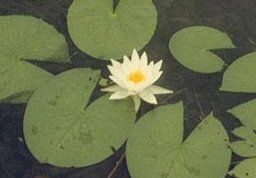Cut Water Lily Pads with the Lake Mower™
Why Use the Lake Mower™ for Cutting Water Lily Pads?

The Jenson Lake Mower™ is proving to be an excellent tool for custom managing water lilies. The beauty of using the Lake Mower™ is that one can cut as much as one needs for the purpose of water resource management or recreation, and leave the rest to keep the fish happy or to look pretty. Unlike when using herbicides, one can aim precisely at those plants one chooses to eliminate. By mowing frequently enough to keep the water lilies from emerging for a full season, the rhizomes are effectively deprived of the nutrients needed to survive the winter and the battle is won. (See DeCaire’s testimonial).
Growth Habit
The white water lily is a perennial plant that often forms dense colonies. The leaves arise on flexible stalks from large thick rhizomes. The leaves are more round than heart-shaped, bright green, 6 to 12 inches in diameter with the slit about 1/3 the length of the leaf. Leaves usually float on the water’s surface. Flowers arise on separate stalks, have brilliant white petals (25 or more per flower) with yellow centers. The flowers may float or stick above the water and each opens in the morning and closes in the afternoon. The flowers are very fragrant. White water lily can spread from seeds or the rhizomes.
Submerged portions of all aquatic plants provide habitats for many micro and macro invertebrates. These invertebrates in turn are used as food by fish and other wildlife species (e.g. amphibians, reptiles, ducks, etc). After aquatic plants die, their decomposition by bacteria and fungi provides food (called “detritus”) for many aquatic invertebrates. Deer, beaver, muskrat, nutria and other rodents will consume the leaves and rhizomes of white water lily, while the seeds are eaten by ducks.
